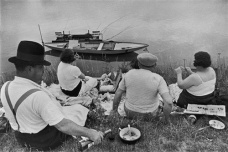
newspaper
agenda cultural
This retrospective exhibition—the first since the photographer’s death in 2004—draws extensively on the collection and generous cooperation of the Fondation Henri Cartier-Bresson in Paris
The two most important developments in photography in the first half of the 20th century were the emergence of lasting artistic traditions and the rise of mass-circulation picture magazines. Henri Cartier-Bresson (1908–2004) was a leading figure in both domains. In the early 1930s, he helped to define photographic modernism, using a handheld camera to snatch beguiling images from fleeting moments of everyday life. After World War II, he turned to photojournalism, and the magic and mystery of his early work gave way to an equally uncanny clarity and completeness.
Before the dominance of television, most people saw the world through the eyes of picture magazines. Early in Cartier-Bresson’s postwar career, his photographs of Gandhi’s funeral and the Communist revolution in China were journalistic scoops. But the vast majority of his photographs describe everyday events, for his essential subject was society and culture—civilization.
Cartier-Bresson began traveling at the age of 22. For nearly half a century, he was on the road most of the time, and the geographical range of his work is notoriously wide. Its historical range is just as broad—from ancient patterns of preindustrial life to our contemporary era of ceaseless technological change. In the realm of photography, Cartier-Bresson’s work presents a uniquely rich, far-reaching, and challenging account of the modern century.
All works in this exhibition are by Henri Cartier-Bresson (French, 1908–2004) and are gelatin silver prints. All of the publications on view in vitrines are courtesy of The Museum of Modern Art, New York.

Henri Cartier-Bresson. Juvisy, France. 1938. Gelatin silver print, printed 1947, 9 1/8 x 13 11/16" (23.3 x 34.8 cm). The Museum of Modern Art, New York. Gift of the photographer. © 2010 Henri Cartier-Bresson/Magnum Photos, courtesy Fondation Henri Cartier

